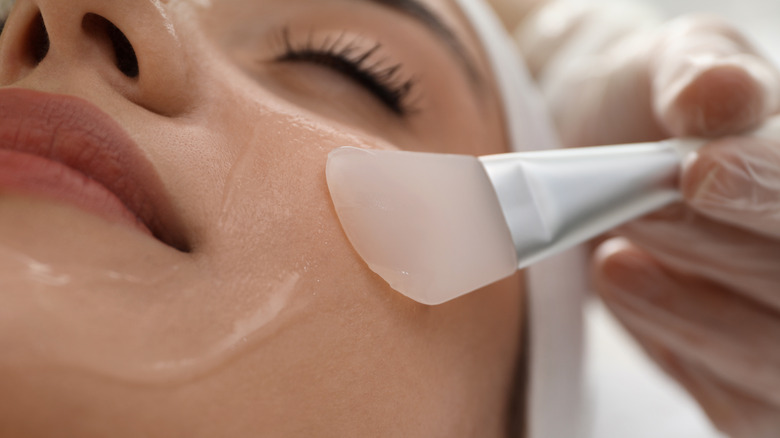Phenol Peels: The Benefits And Risks, Explained
Let's be honest: We invest so much in our skincare because, deep inside, we're hoping the products and skincare treatments we try out yield something that can help us figuratively go back in time — a time when our skin cells were younger, smoother, plumper, and haven't succumbed to environmental stressors and natural aging yet. The closest we've gotten to that are chemical peels, which remove the top layers of the dermis to encourage the growth of new, blemish-free skin. Phenol peels are on the deeper and more aggressive side of the chemical peel spectrum. They use phenol or carbolic acid to penetrate deep into the skin and create a controlled injury, which prompts the skin-resurfacing action chemical peels are known for. However, because a phenol peel is so intense, with a longer recovery time, it's a treatment unlike the typical peel people frequently get.
"A phenol peel is only recommended for those with moderate to severe acne scarring, deep wrinkles, or sun damage from chronic UV exposure who are not candidates for other types of treatments," dermatologist Blair Murphy-Rose specified to Allure. Because it's quite an intense procedure, just one session yields dramatic improvements that last for years. But the risks may outweigh the benefits.
Pre-treatment requirements and considerations
Due to its potency, only board-certified dermatologists and plastic surgeons can administer phenol peels. Before the procedure, patients undergo evaluation for skin conditions such as hyperpigmentation and rosacea, which could worsen with chemical peels. If you have a darker skin tone, HelloGiggles reports that you may get better results with a milder peel that only works with the top layer of skin. "A major risk of chemical peels for Black skin is worsening of dark spots or hyperpigmentation of the skin," board-certified dermatologist Dr. Ife Rodney told the publication. "Because this risk of skin discoloration is much greater in dark skin, it is very important that you see a dermatologist with expertise in the use of peels in Black skin.
Phenol peels can cause heart problems as well, which is why the procedure must be performed in a clinical setting, complete with cardiac-monitoring equipment. Doctors also offer patients sedation or IV anesthesia on top of topical anesthetics to help them endure the pain. Not surprisingly, with all these considerations, a phenol peel session costs $4,233 on average (per Real Self).
What happens during a phenol peel session?
Liquid phenol is applied to the face in segmented, sequential cycles. Since overdosing on phenol poses cardiac, renal, and liver risks, per Mayo Clinic, doctors allot 20-minute pauses between the acid application on different sections of the face. This measured administration pushes the procedure to potentially take as long as two hours. Once they are done, doctors coat the treated area with Vaseline, which also functions as a semi-occlusive dressing. They also cover the face with a tape mask that gets removed the next day. Patients may be prescribed antiviral and pain medication.
The old skin begins to peel within the first week after treatment. As this happens, you can experience intense erythema (skin redness), a burning sensation, inflammation, and oozing blisters. Later on, the skin begins to scab over. No matter how itchy it gets at this stage, scratching or even rubbing the treated skin must be avoided to prevent infection. Once the scabs fall away, a smooth but raw-looking new layer is revealed.
Dermatologists strongly advise against wearing makeup for at least two weeks after treatment. Patients would also need to apply sunscreen religiously after their skin has healed to avoid damaging and burning the new, delicate layer of cells.
A last-resort procedure
Phenol peel's promise of erasing wrinkles, scars, and signs of deep sun damage has made it a hot TikTok topic. It's also incredible to see the stark difference between the patients' before and after pictures. However, there are reasons why dermatologists are careful in recommending this procedure, aside from its cost and extensive precautionary requirements.
Unlike milder chemical peels you can squeeze in between appointments, a phenol peel needs a lengthy recovery period of about four to six weeks. The treated area is basically an open wound so following the doctor's aftercare directions is necessary. These include the routine application of emollients and occlusives and the diligent avoidance of sun exposure for 3 to 6 months. Recovering from such a deep chemical peel is also not always a straightforward experience. Infection can occur, along with scarring and pigmentation, per Mayo Clinic, and redness can also last for three months.
Its promise of turning your skin into a blank slate is enticing but a phenol peel isn't a treatment to sign up for on a whim. Consult your dermatologist for gentler options to try first to reach an informed decision.

